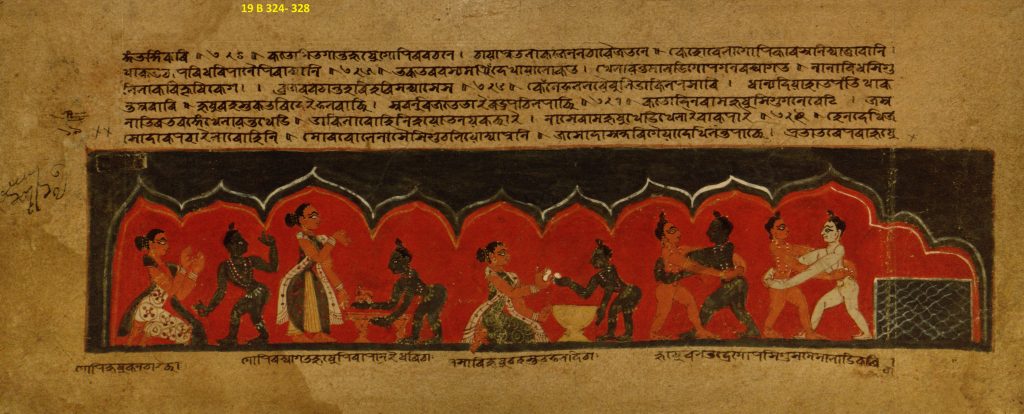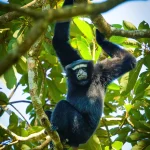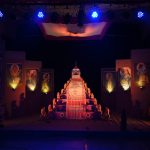Symbolism is a style of representing any particular idea by using symbols. These symbols are endowed with additional meanings apart from their literal meaning. Symbols enable reader or audience to grasp something beyond what is traditionally conveyed by the symbols. The symbol communicates something beyond itself. A symbol is a visible object with which the reader or audience is aquainted with, because of which it is used to convey the particular idea by the author. The particular object used as symbol should have some features similar to the particular idea, because of which it is quickly associated with the idea sought to be conveyed. The commonness of the symbols and the concerned ideas enables the author more ease to covey his message. The reader or audience can link the symbol with the concepts or ideas sought to be conveyed by the author. Symbolism became popular in the realm of literature and culture in the late nineteenth-century. Poets and artists of French, Russian and Belgian origin represented what they thought to be truths symbolically. They used metaphorical images and language for that purpose. They came away from naturalism and realism in the process. In literature, the 1857 work of Charles Baudelaire’s Les Fleurs du mal is considered as the first work of symbolism. Maurice Maeterlinck (1862-1949) used symbols to convey his ideas about spirituality, existence etc. He authored symbolist play like Pelleas and Melisande (1892). The term ‘symbolist’ was first applied by the Greek poet, essayist, and art critic Jean Moreas. But contrary to all these popular perception and records, saint litterateur Srimanta Sankaradeva had used this style way back in the fifteenth-century. We will show how he was the actual pioneer of Symbolism.
The works of Srimanta Sankaradeva were full of symbols. In fact the very first Ankiyā play Chihna Yātrā enacted in 1468 signified his journey in the symbolist style. The word Chihna in the name Chihna Yātrā itself implied symbol. Backdrops were put up in the stage with painting of Vaikuntha (heaven). All the structures placed in the stage were symbolic of Vaikuntha. The maestro wrote the play and enacted it on the request of his elders who wanted idea about Vaikuntha. Thereafter he authored nine more plays in his own style. These Ankiyā plays had many components which stood as symbols for something else, in addition to fulfilling the requirement of the play. For example there is a prop named Agnigarh used in these plays. It is a decorated gate through under which the divine characters of the play as well as the Gāyan Bāyan (singers and drummers) play enter the arena. There are nine lamps lit over the arch of this gate. These symbolise nine modes of devotions. Whoever enter through this gate are those who subscribe to these types of devotion, which is prescribed in the Vaishnavite orders. Two āriyās are kept on both sides of the Agnigarh. These are for lighting the arena. At the same time these two also signify the two specific modes of devotion prescribed by Srimanta Sankaradeva; these are Shravana (listening) and Kirttana (chanting or singing). Community singing of name and attributes of God is a basic feature of the saint’s Eka Sarana Nāma Dharma. The Gāyan Bāyan bring these āriyās when they enter the arena and then put them beside the Agnigarh. So Agnigarh and āriyās signify the religious philosophy of the saint. It is significant in this context that the demonic characters or unethical characters in the Ankiyā plays do not enter through the Agnigarh. This is because they do not subscribe to the devotional requirements of the order. Such characters are outside the purview of devotional order. They are always shown as vanquished in the Ankiyā plays. Divine characters always defeat them. A cloth called Pāmori bastra is lifted when such characters enter the arena. This cloth stand for Māya (illusion); one gets enlightenment about divinity when one’s illusion is removed. As long as illusion about and attachment for mundane things are there, one cannot understand the divine. Realisation about God is not possible as long as one is under the spell of Māya. In the writings of Srimanta Sankaradeva, there are repeated prayers to God to remove his Māya. That this is crucial in the spiritual journey of a devotee is highlighted by the fact that the Pāmori bastra has to be lifted before any divine character enters the arena. The activities of the divine characters in the arena stand for spiritual truth; the devotee gets to see the truth only after the Pāmori bastra is lifted.
There are many other objects used in the Eka Sarana Nāma Dharma, which are symbols for religious ideas. The Guru āsana or the altar is one such object. Seven layers of the altar symbolise seven heavens. The sculptures of elephant, tortoise and flying lion on four corners of each layer signify the evil, devotee and God’s name respectively. The flying lion overpowers the elephant in the joint sculpture, both atop the tortoise. Evil is always mighty and powerful, but it can be overpowered by the prowess of God’s name. The devotee is like the tortoise and can restrain himself just like that animal. Positioning the flying lion and the elephant atop the tortoise signifies that the conflict between good and evil in an internal process going on inside the devotee. That there are twenty-eight total such joint sculptures imply that the devotee should take care of his twenty-eight senses and organs. These are two arms, two legs, two eyes, two nostrils, mouth, mind, intellect, consciousness, ego etc. The devotee has to develop total control over all these. The pyramidal structure of the Guru āsana is also symbolic. It signifies the elevation of devotees subscribing to wide variety of beliefs to the level of perceiving the supreme non-dual absolute being; it represents the Vivartanavāda philosophy of the saint.
Metaphor is an important element in symbolism. It is a figure of speech through which symbolism is practised. Such words have additional meanings to their literal meaning. They actually have something common between them. These two unrelated things share a common characteristic. Metaphors can therefore compare two things that are not apparently similar. Metaphors are used to draw comparison between two distinct objects. Metaphor is a part of symbolism which is a much more complex process; symbolism signifies abstract ideas whereas metaphors signify objects. In literature, a metaphor is typically used to compare two objects, but symbolism is there throughout the work as a theme. Anything can be used as metaphor as long as the link can be directly made; it has to be understood easily too. We find many such metaphors in the symbolist works of Srimanta Sankaradeva.
Most of the books authored by the saint litterateur contains many metaphors. The most illustrative among these is the book Kirttana-ghoshā. It contains several chapters, each of them narrating a different story. In the Gajendra upākhyāna chapter of this nook, an elephant Gajendra comes under the clutch of a crocodile Grāha while frolicking in a pond. There is fierce conflict between the duo, but Gajendra cannot escape the strong grip of Grāha. Eventually Gajendra prays to lord Hari to save him, holding a lotus by his trunk, whereupon he is saved. The mighty elephant symbolizes the creature under the spell of illusion and the crocodile symbolizes illusion. The Eka Sarana Nāma Dharma order uses the metaphor of elephant as that of sin also; the sculpture of elephant being overpowered by a flying lion is embedded in the altar of Kirttanghar. So when Gajendra submits to God, that means the sinful creature has surrendered to God seeking redemption. Lotus in his trunk means purity. In other words, he has already become pure, discarding his ego that he is a mighty entity. So the elephant, the crocodile and the lotus are metaphors.
Life and glory of lord Krishna is a constant topic in the writings of Srimanta Sankaradeva. The weapons of lord Krishna are personified in the chapter Jarāsandhar yuddha of Kirttana-ghoshā. The description goes like Āila astrachaya chakra pramukhye / Krishnaka namilā āsi Dāruke. That means the weapons including the disc arrived and charioteer Daruka prostrated before Krishna. All these are nothing but metaphors. These weapons are the instruments for annihilation of the evil. Their personification is echoed in the chapter Vipraputra ānayana also. It describes like Chakra ādi ashtre murtti dhari / Sewā kare Vishnuka āvari. That means the personified disc and other weapons surround and prostrate before lord Vishnu. The chapter Sri Krishnar Vaikuntha prayāna also describes in similar tone like Murtti dhari astra chaupāse āse. That means the weapons personified are on four sides (of lord Krishna). Repeated allusion to personification of the weapons means that these weapons are nothing but metaphors. Shankha (conch) is a means of announcing the arrival of a new philosophy, a just order, the order of righteousness. Chakra (disc) means full annihilation of the incorrigible criminals. The Gadā (club) is used for forceful suppression of the heretics.
The devotional songs Bargeet authored by Srimanta Sankaradeva are also full of metaphors. In one such song, he says Nāma panchānana / nāde palāvata / pāpadanti bhaya bhita. That means the sin elephants flee in fear on the growl of name lion. Here lion is metaphor for the name of God and elephant for sin. In another song, he says Hridaya kamale Hari baithaha. That means God resides in the heart lotus. The lotus is metaphor for heart in this song. The heart of the devotee should be as pure as lotus. So his metaphors are very significant and used very judiciously. Yet another song contains the line E bhava gahana bana / āti moha pāshe channa / tāte hāmu harinā berāi. That means the mundane life is a dense forest where we deer graze, bounded by strong attachment. Here mundane life is implied by dense forest and the creatures by deer. The saint litterateur conveyed his cynical comments too through metaphors. That there are many frauds in the garb of religious preceptors is conveyed through the line Bhārata hātata āse aneka dokāni in another song. Here dokāni (shop-keeper) is metaphor of preceptor. As the entire country is full of many such frauds, he compares the land itself with a hāt (market).
Allegory is another important aspect of symbolism. It is a narrative in any literary content, where a character, place, or event is used to convey a broader message about the theme or issue or happening in that literary content. It is generally used to illustrate or convey complex ideas and concepts in such a way that the readers or audience can understand it. Different interconnected symbols or allegorical figures are used in it. Every element of the narrative is conferred meaning beyond the literal level. We find many such allegories in the symbolist works of Srimanta Sankaradeva.
The description in the chapter Rāsa krirā of Kirttana-ghoshā is an allegory of the union of the individual self with the universal self as the Gopis are none but individual selves aspiring for union with the supreme almighty. Lord Krishna in the Rāsa krirā is none but the supreme absolute or the universal self; the author himself says that categorically in the first chapter of Kirttana-ghoshā. The Gopis of Vrindavana are the individual selves. The merger of the individual selves in the universal self is symbolised by the Rāsa krirā. It is not something physical, but spiritual.
All the Ankiyā plays of Srimanta Sankaradeva are examples of allegory. These plays are Chihna yātrā, Patni prasāda, Kāliya damana, Keli Gopāla, Rukmini harana, Pārijāt harana, Janma yātrā, Gopi Uddhava sambāda, Kangsa badha and Sri Rām vijaya. Only six of them are now available. Each of these plays convey some embedded message, thereby making the entire play an allegory. For example, the Ankiyā play Pārijāt Haran is an allegory, which conveys the glory of devotion and uselessness of ego in the context of God realisation. The heavenly flower Pārijāt (Night Jasmine) symbolises boon from God. It came out during the churning of ocean and was planted in the garden of Indra in heaven. Sincere devotee Rukmini receives it from lord Krishna without even asking. But the egoist Satyabhama has to go through a lot of stress before getting it. Indra has arrogance and he thinks he can control the happenings, but he is overpowered by God; he hands over the plant to lord Krishna only when his limitation is pointed out. Ultimately it is the will of God that prevails; neither ego nor mundane power can prevent the God’s will. This is the message of this play.
The play Kāliya damana is a way of sending the message that evil and mundane prowess is always overpowered by the divine power. Ego and arrogance cannot withstand before divinity. The serpent Kali is overpowered by lord Krishna and forced to leave the lake he was polluting with his venom. The play Patni prasāda declares the uselessness of knowledge devoid of devotion. That devotion is greater than knowledge is conveyed by the story. The pious wives of the Brahmin priests feed lord Krishna and his friends, after the refusal of their husbands. Eventually the priests realise that their knowledge is meaningless because of their ego and lack of devotion. They too become devotees of lord Krishna.
The allegory character of the Ankiyā plays comes out prominently in its performances. Bhāonā, the performance of Ankiyā play is entirely an allegory. It is nothing but a worship of God. That is why an altar is kept in the place of its performance. The Dherāpāk performed at the outset of Bhāonā signifies the four cornerstones of the Eka Sarana Nāma Dharma order; these are Guru (Preceptor), Deva (God), Nāma (Name of God) and Bhakata (Devotee). Any devotee in the order has to have allegiance to these four. The Dherāpāk is performed by the Gāyan Bāyan in the shape of the number four. They remind the audience about the four cornerstones of the order. Such symbolism is there in all aspects of the Bhāonā. The use of Pāmori bastra tells the audience that they should get rid of mundane illusions and try to realise the divine. Two āriyās kept in the arena remind them that Shravana and Kirttana are the best ways of devotion to God. The blue colour of lord Krishna’s body signifies the infinity. Costume of the anchor of these plays, Suttradhāra is also symbolic. It is neither male dress nor female dress. His dress reflects the transcendental nature of God, the ultimate anchor of the creation.
Srimanta Sankaradeva is clearly pioneer of symbolism in the entire world since his symbolist works preceded those of Charles Baudelaire, Maurice Maeterlinck etc. His play Chihna Yātrā (1468) was the first symbolist play in the entire world. This symbolist character was continued further by Srimanta Sankaradeva’s disciple and successor Madhavadeva in his own genre of play the Jhumurās.




